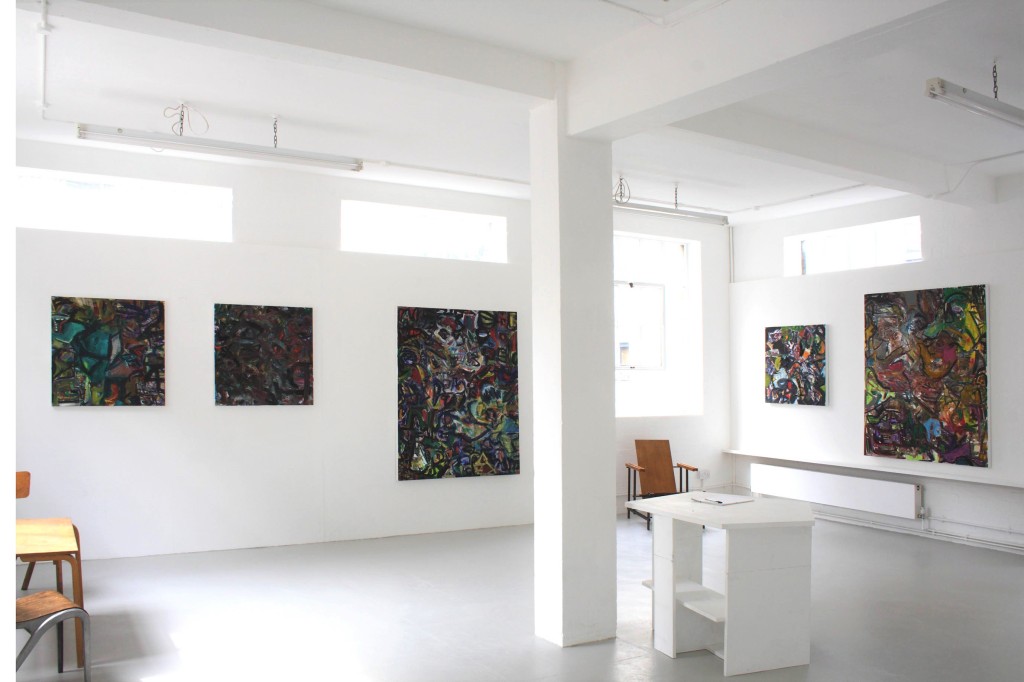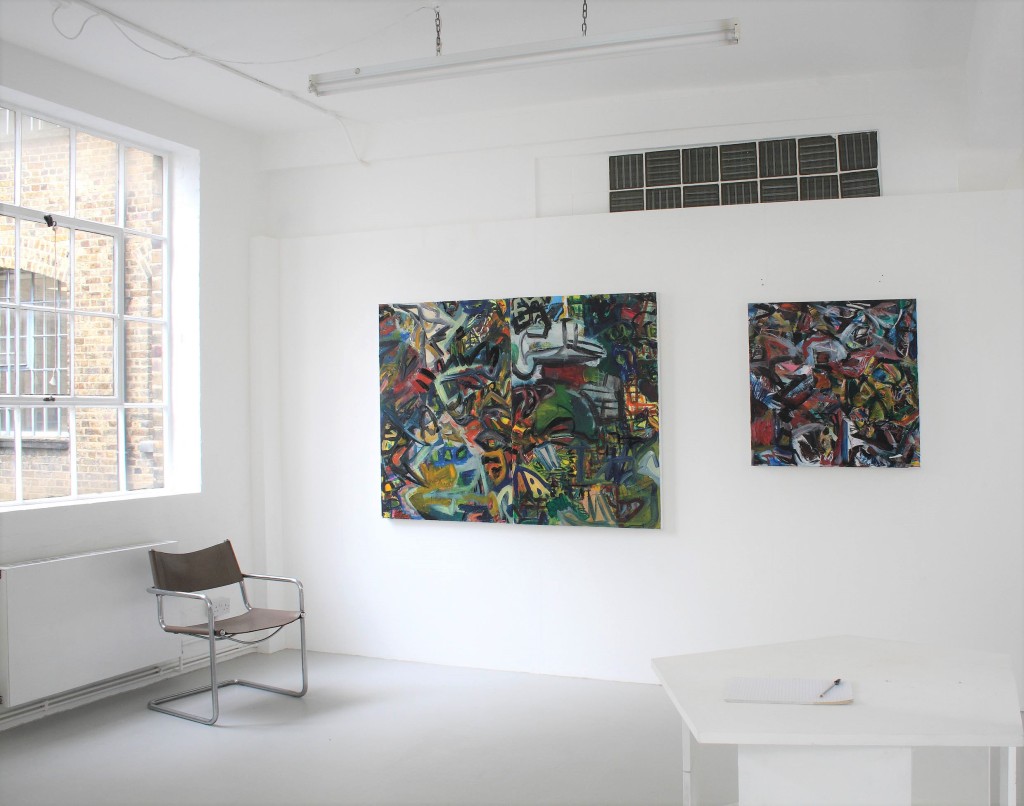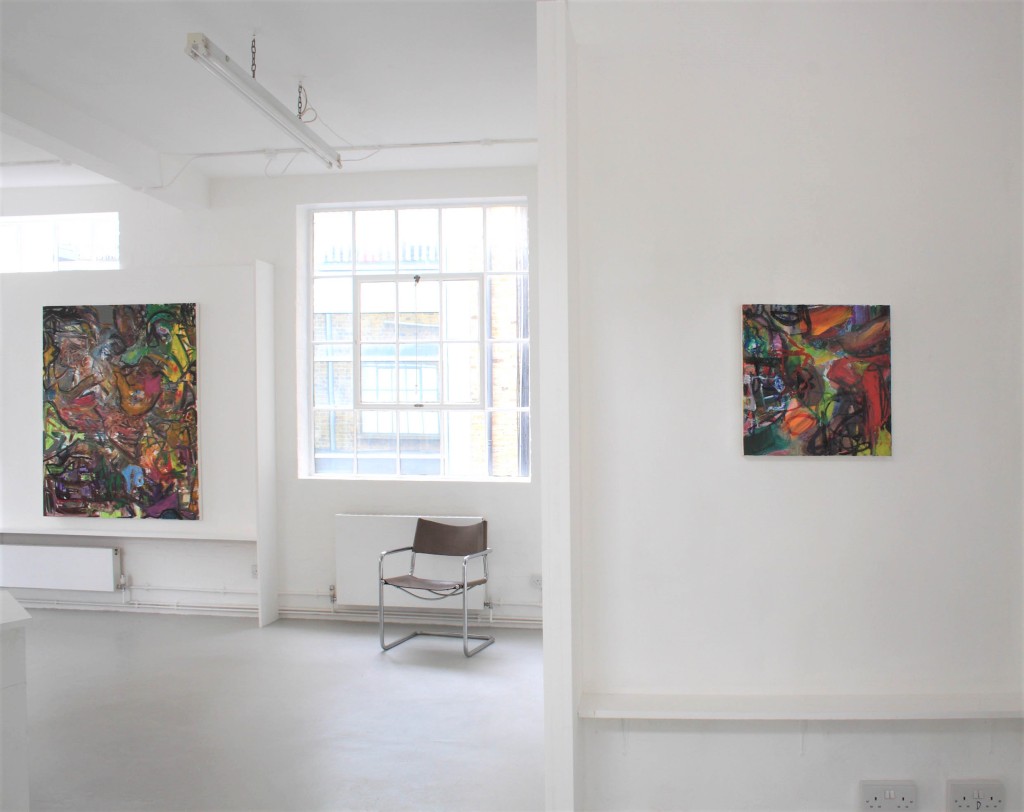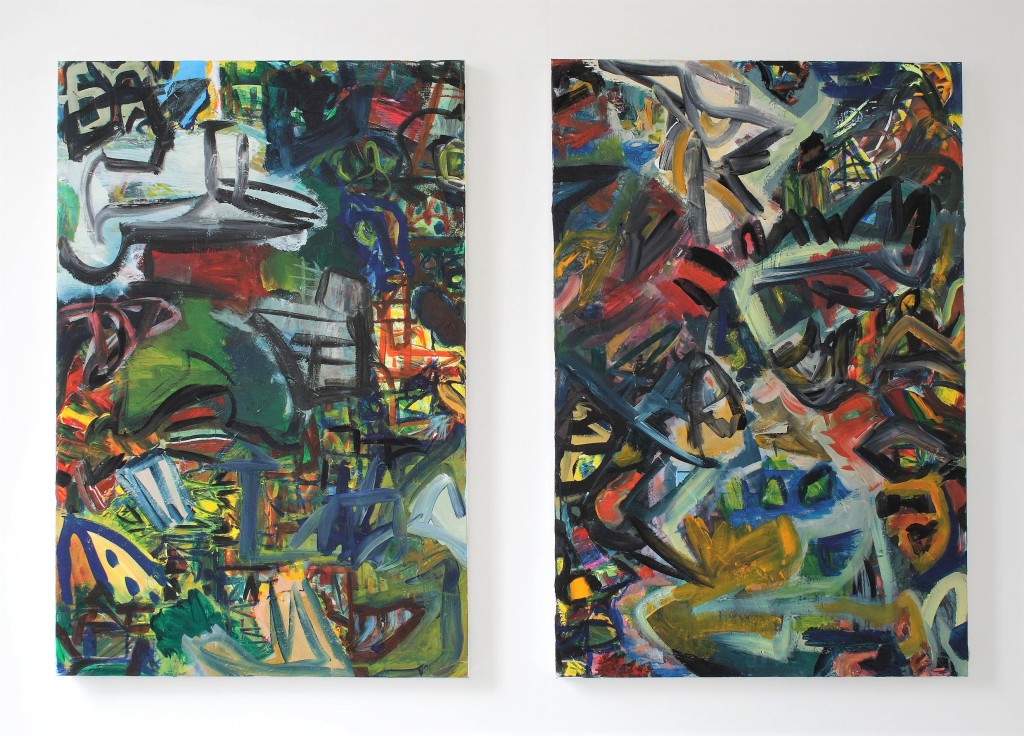
Exceptional abstract paintings that need to be seen for real.
Exhibition opens Saturday 30th April 2022, until Sunday 29th May.
Visit by prior appointment.
Text your name and requested date and time to 07866 583629, for return.
…
abcrit.org
Block K
13 Bell Yard Mews
175 Bermondsey Street
London SE1 3UW
The entrance to Bell Yard Mews is opposite White Cube in Bermondsey Street.
Block K is at the rear of the mews: the gallery is on the 1st floor, no lift.
This is the seventh exhibition of abcrit.org
…
All paintings are in acrylic on canvas.
Works in the exhibition, clockwise from entry:

“Zaffa”, 2021, 80x80cm
“Hid Dud”, 2021, 80x80cm
…

“End of Times”, 2021, 80x80cm
“Brave World”, 2016, 150x120cm
…

“39 Times”, 2021, 80x80cm
“Tempered Grace”, 2021, 80x80cm
“Insignia of Lockdown (Gupta’s Tears)”, 2021, 150x120cm
…

“Daemon Times”, 2021, 80x80cm
“Phainesthai”, 2017, 150x120cm
…

“Fondamenta Dei Mori”, 2021, 160x120cm (diptych)
“Spinner”, 2021, 80x80cm
…

(on the right) “Cross-Speeding”, 2021, 40x40cm
…
All paintings are for sale.
150x120cm – £2,700
120x160cm – £2,850
80x80cm – £1700
40x40cm – £800
…
Comments can be made on abcrit.org both before and after visiting. Submissions are moderated.
…
ADDENDUM
After discussion on site between John Pollard and Robin Greenwood, it was decided to hang these works the other way round, left to right, and with a small space between them.

“Fondamenta Dei Mori Part 1”, 2021, 120x80cm
“Fondamenta Dei Mori Part 2”, 2021, 120x80cm
Looks great Congratulations Patrick
Sent from my iPhone
LikeLike
Looking forward to seeing this Robin, in the flesh.
Sent from my iPad
>
LikeLike
Read this today on YouTube: J. S. Bach – The Well-Tempered Clavier, Book II – Glenn Gould
Gould launched his complete recording of the “Pianists’ Old Testament” on 10 January 1962. It would eventually occupy him for more than nine years. “We recorded ten or even fifteen different versions of some of the preludes and fugues. Nearly every one was perfect, note for note, yet still completely different. It was an amazing experience to witness how each version became something completely new in Gould’s hands.”
LikeLike
Much to learn…
LikeLike
I wrote this a couple of years ago, obviously about abstract sculpture; but it seems to me to potentially connect with John Pollard’s paintings.
“Fluid spatiality offers possibilities for varied interpretations of the work in the act of the onlooker moving around and observing the possibilities of “everything” in the work, or as much as is available, from different directions. And this can continue coherently on each new viewing occasion, provided that the content is complex enough to “hold and accumulate” that variety of experiences; and provided that there is available a recognition of at least some degree of wholeness – though this may need to be open-mindedly worked on. One person’s wholeness may be another man’s muddle; but one person’s suggested or “gambled-upon” wholeness is also a possibility of fluidity.
Let’s say the more diverse, complex, and demanding the experiences of abstract sculpture, the better, though it increases the difficulty in both making and viewing. Can we just say that making abstract art is and should be difficult and complex, at least until such time as we understand more about it? The more we put in, the more we are going to get out, perhaps even when failing.”
Maybe, in the best new paintings, “different directions” are becoming more real – less of a fantasy.
See this work!
LikeLike
Robin, we started talking about ‘complexity’ recently and you suggested we have the conversation here. While we both often use the term to describe abstract art that we value we do have some different ideas, which may be interesting to explore, and perhaps others can join in as well? You sent me an image of a painting that you thought was complex and poor. I didn’t think it was complex. Can you post that painting and we can riff from there?
LikeLike
Hi John,
I can’t remember who that awful painting was by, but it was complex. To make life harder for myself, I’m reproducing a Tintoretto, the artist we both rate very highly, and who makes very complex paintings. But here is one that I nevertheless think is poor:
https://www.nga.gov/collection/art-object-page.46142.html#:~:text=Before%20he%20became%20known%20as,to%20destroy%20the%20churches%20there.
You can’t say it isn’t complex, but you can say it’s a mess.
We agree about the importance of complexity in new abstract painting, but from my point of view, it does not mean “complex” is “good”. There must be other things working in the paintings. For example, “coherence”. This painting does not have it. It’s a complex mess.
If you look for a definition of complexity in Roget’s Thesaurus, you will find lots of differences from your ideal – like, of course, “complication”. So I think you need to define your use as a be-all and end-all definition of what comprises a good abstract painting. Or modify “complexity” with other things.
I would add that it is of course possible to make “simple” abstract art, but we might agree that it has been done (to death?).
LikeLike
I think it’s helpful to see complexity on a scale (with simplicity at the other end). The Tintoretto you mention is not that far on the complexity scale. The figures are stilted, static and don’t have the dynamic movement that Tontoretto achieves at his best. There’s plenty of big, simple, spatial relationships as well throughout the whole work (e.g. in terms of colour, shape, tone, form). To be fair to him I think it looks better in the flesh (probably more complex). There’s more of course, to be said about good work apart from that it’s complex, but it’s the most important term for me and an interesting one to explore. So I guess I’m saying that it’s not that complex.
LikeLike
So do you think work with simplicity is never any good?
LikeLike
You could argue that succesful complex work can have areas of simplicity but if the areas become too big you have a less interesting painting. Simplified space taking up too much of an area in a painting becomes very boring (I often call this a simplistic figure-ground relationship). It really isn’t going to hold your attention for very long and I don’t think this simple work is very ambitious or interesting for me as a painter or viewer (once it was but things change and develop). There is something very important for me which is that the whole work is rich with activity, meaning and value. I like diversity within the work but I try not to let one element dominate.
LikeLiked by 1 person
I think we agree on much of that.
And the diversity of new inventions in the work becomes more important as we advance into free abstract art. Attempting more of this diversity, whilst keeping things “running along” together, is a very exciting prospect. There are two or three works in this show that take this on.
LikeLike
There are some strong paintings in this show. Uncompromising and challenging for the viewer, they need time for looking in order to reveal and understand the complexity within them.
‘Zaffa’ and ‘End of Times’ really work for me, they look good together (I was allowed to see them next to each other, thank you Robin). They are perhaps ‘simpler’ than some of the larger works but they have a strength and directness which creates space and light around and within abstract forms. John pollard’s ‘abstract worlds’ are very evident in these paintings.
‘Insignia of Lockdown’ has a frenetic quality, and ‘Phainesthai’ is just wild!
The linear elements in ‘Phainesthal’ that scoot and fly around the canvas create a cacophonous excitement, this painting demands long gazing to see how the textural and pooled areas interact to create wholeness.
Definitely this show needs to be seen in real life, screen viewing does not do it justice.
LikeLike